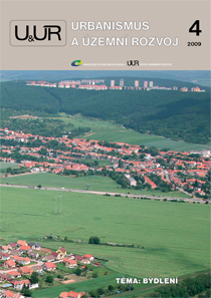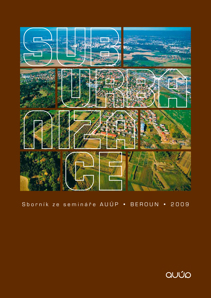

Analyzing the Distribution Aspects of Rent Regulation/Deregulation in the Czech Republic, by Robert Jahoda & Dagmar Špalková
Rent regulation has had a tradition of almost 90 years in the Czech Republic. The protection of tenants from inadequate rent and its growth, applying for most rented flats, was important in the times of economic transformation. In recent years, though, it became one of the most rigid tools of the housing policy. Its rather obsolete form has caused that the target group of protected tenants was enlarged by many of those who are not indigent. It was only in 2006 when a law entered in vigour enabling an annual unilateral rent increase, for a total period of four years, in order to support the rent deregulation and, thus, liberalize the housing market. Two years after the process was started, there is a question: What is going to be its impact on the households? Can the costs of housing remain within the bearable? The aim of this article is to evaluate the experience of the hitherto rent deregulation. Based on the EU-SILC research data, the opening part comments on the social status of the households on regulated rent, observing the regional differences in the costs of housing. Through a micro-simulation model, part two of the contribution evaluates the potential impact of the legal rent deregulation.
The Scale and Present State of Privatisation of Municipal Housing Stock and its Possible Impacts, by Jan Česelský
The interconnectedness of the market approach with social aspects has become an extraordinary sensitive question at the transformation of housing policy in the Czech Republic. In spite of existing dominant trend based on the “economisation” of housing sector, the social groups which are disadvantaged in access to their adequate housing and are entirely dependent on the public service assistance, i.e. in our country's conditions particularly on municipalities. The paper deals with housing problems at municipal decision level. It presents, provides documentary evidence and evaluates the present status of the privatisation process of housing stock in the Czech Republic, compares this status to other advanced European countries and predicts the impact of present situation on further development in the housing sector at the level of municipalities and cities.
Interregional and Intraregional Differences in the Accessibility of Market Rent Housing, by Martin Lux
& Martina Mikeszová
This contribution is focusing on the analysis of regional differences in the financial availability of rent housing in the Czech Republic. The analysis is based on a new measurement methodology, reckoning with the inapplicability of the survey sampling for regional segmentation. The aim was to tell whether the disparities in the financial availability of rent housing among Czech regions, and among various household types, had been decreasing or increasing between 2000 and 2007. Based on the results, selected Czech regions’ specifics in the financial accessibility of housing were identified.
Czech Household Migration for Employment and the Housing Market on the Regional Level, by Petr Sunega
The objective of this contribution is to highlight the interconnection between the labour and housing markets, with the housing market barriers (mainly the increasing owners’ share) potentially obstructing the household migration for employment. The Czech Republic has always belonged to countries of scarce internal migration, which is partly caused by geographical reasons (such as the relatively small distances among employment centres) and the density of transportation networks (relatively good commuting opportunities, thus a large portion of commuter households). Yet, foreign studies show that high numbers of apartment/house owners can also be a barrier of higher work mobility, with the negative influence of legal grounds to use being documented in the Czech environment too. The extensive privatization policy of municipalities can thus have one unintended impact: increasing unwillingness of Czech households to move to places of job opportunities. The regional unevenness in the financial accessibility of housing is another factor which (as shown by examples of various household types) may be a burden, especially for individuals and/or households of lower qualifications. On top of that, regarding the development of the financial accessibility of housing, the difference between the migration opportunities for the higher and lower qualification groups of labour force was increasing between 2000 and 2007.
Disparities in the Physical Accessibility of Housing in the Administration Districts of Selected Municipalities with Extended Powers, by Michal Hadlač, Milada Kadlecová and Milan Polednik
Czech regions differ in economic efficiency, employment rates and, last but not least, the accessibility of housing. Housing accessibility is closely connected to physical planning, as the offer of development zones is largely determined by the master plans of municipalities, differing in its extent, allocation and, consequently, their physical accessibility. It is not only regions but especially the administration districts of the municipalities with extended powers where the analysis of development zones clearly shows disparities in their dimensions and allocation as related to respective centres and other settlements.
Housing for Young Graduates Researched, by Renata Zdařilová & Martin Ferko
One’s satisfaction and ideas about housing is always related to age. Surveys about housing have shown that it is young people under thirty who are least satisfied with where they live, which reflects the objective differences in housing. To show the current view of the prospective living of fresh university graduates was the purpose of a study carried out within a research programme of the Ministry for Regional Development.
Conditions for Accessible and Dignified Housing with Emphasis on the Barrier-free Design, by Renata Zdařilová
The aging of the population and its prospective trends are problems of continuously increasing importance. The housing stock must support and create conditions for seniors to be able to live in their socially natural environment, enabling them to receive care within their families. The objective of such attention to housing for seniors should be to postpone or avoid their leaving to places and institutions in which they are separated from their families and lose the hitherto social contacts. The requirement to generate conditions for a dignified and adequate housing for seniors goes hand in hand with the necessity to correspondingly conceive every new residential building and, subsequently, each tenement.
Housing in Spatial Analysis, by Jana Podzimková & Tomáš Vaško
This contribution treats housing as part of the documents of regional and municipal spatial analysis. The Building Act specifies the purpose and the contents of spatial analysis, listing the phenomena and subjects under obligatory observation, but practice indicates that for efficient elaboration and a subsequent applicability of the analysis, the minimum requirements for certain subjects should be much more precisely specified. The examples of housing in the spatial analyses of the municipalities of the Liberec Region show that inconsistent documents were produced, the applicability of which for the master plan and the regional spatial analysis is very doubtful.
The Housing Policy of the Capital City of Prague: The Housing Stock of the Capital City of Prague not Entrusted to Urban Neighbourhoods of the Capital City of Prague by the Statute of the Capital City of Prague, by Tomáš Trejtnar
The Capital City of Prague offers help in form of housing only to people who got not by their own fault into a difficult social situation and who in spite of all their efforts were not able to ensure an appropriate housing by their own financial means. The housing is being provided only over the period of neediness. At the same time, regular controls of dwelling stock by authorized tenants are carried out and new conditions of housing support are created.
The Housing Policy Concept in Hradec Králové, by Markéta Baldrychová
The housing policy concept of the city of Hradec Králové of 2003 is a basic document in which the city council intentions in the field of housing are determined. The concept strategy aims to support functional housing market and, in compliance with the State housing policy, to create conditions for financial accessibility of habitable dwellings for the citizens. The concept includes an analysis of the present status and suggestions for the solution of housing problems in several fields, among which the most important are the support of housing construction, privatization of City dwellings as well as support of individual and entry-level housing projects.
The Housing Policy Concept and the Housing Development in Uherské Hradiště, by Jaroslav Bičan
The articles dealing with housing issues mostly begin with the statement that housing is one of the essential human needs, which, in its quality as a goods, shows certain specifics in comparison with commodities. The text then usually continues that the desirable status to be achieved is the balance Between housing market and the financial accessibility of appropriate housing even for those belonging to low income citizen groups. However, the instruments to attain this aim are administered by Central Government whereas the municipalities dispose only with restricted means in the realization of State intentions because their role in the field of housing is so far inexplicit.
When drawing up local concepts of housing policy, The City Councils can't go from generally applicable recommendations or methodologies. If they want, on a long-term basis, to coordinate the housing development beyond the framework of local plan as their basic instrument, they have to rely upon themselves and apply their own procedures in the creation of concepts. This is also the case with “Housing policy concept of the Uherské Hradiště” of 2005, which tried to summarize and classify the views of City Representatives on the role of self-government in the local housing system. In the first part of the document, the background and conditions of housing development in the city are assessed, followed by the characterization of the self-Government objectives and intentions in the operation of own housing stock as well as by suggestions for further support of housing development in Uherské Hradiště.
Motivation for the Motion of Visitors to Olomouc’s Town Centre, by Jaroslav Burian & Jan Heisig
The article presents the results of a project focused on the motivation for the motion of the visitors to the centre of Olomouc. Using the questionnaire method, the authors were investigating in the quantitative and qualitative characteristics of the purposes of the visits to the two main historic squares in the centre. Data collection was carried out in October 2008, asking the respondents about the purport of their visit, the starting point and the destination of the trip, their age, gender, the form of transport into the town centre, and the entry they had used to walk in the square. Statistically identified were the tendencies and correlations among the characteristics to be further presented and commented on.